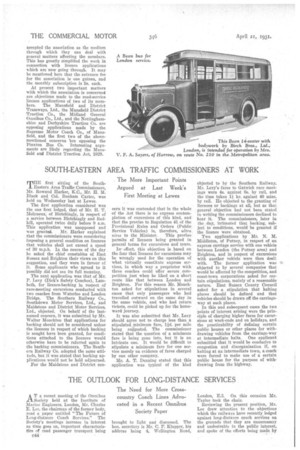THE OUTLOOK FOR LONG-DISTANCE SERVICES The Need for More Crosscountry
Page 66

Page 67

If you've noticed an error in this article please click here to report it so we can fix it.
Coach Lines Advocated in a Recent Omnibus Society Paper AT a recent meeting of the Omnibus Society held at the Institute of Marine Engineers, London, Mr. Charles R. Lee, the chairman of the former body, read a paper entitled "The Future of Long-distance Coach Services." The Society's meetings increase in interest as time goes on, important characteristics of road passenger transport being
014 brought to light and discussed. The hon. secretary is Mr. C. F. Klepper, his address being 4, Wellington Road, London, E.3. On this occasion Mr. Taylor took the chair.
Reviewing the present position, Mr. Lee drew attention to the objections which the railways have recently lodged against long-distance coach services on the grounds that they are unnecessary and undesirable in the public interest, and spoke of the efforts being male by the railway companies to co-ordinate their train services with the road services in which they are interested. He expressed the view that the independent operators of lang.-distance coach Services, unless they could gather strength by' association in one form or another, will disappear or be absorbed into the larger groups.
Speaking of the430-m.p.h. speed limit, he submitted that this would result in average speeds of between 22 m.p.h. and 24 m.p.h., and mentioned the fact that the seven-seater-coach, which is not subjected to the speed limit, has been experimentedwith for high-speed services. He did not see much of a future for this type of vehicle On regular services, but it was noticed that he made no reference to their usefulness as auxiliary. vehicles.
Probably the most important point which Mr. Lee raised and one which was taken up keenly in the subsequent discussion, was that, apart from cheapness of fares, the -facility, of being able to book one's seat in advance had been an important factor in the growth of popularity of mothr-eoach, services, As, according to the Road Traffic Act, 1930, all publicservice vehicles must have road-service licences, he foresaw difficulties over the seat-booking practice, explaining that a licensed vehicle has no power to refuse a prospective passenger provided there is a seat available. This, might result in a far greater use of coach stations. Regarding the' strength of the. railway companies ,andthe other big groups of road-service operators, he emphasized how the new' regulations reladng to drivers' hours would be more easily complied with by suck powerful concerns than by smaller operators, adding that the extensive garage 5faciliti6s of the big companies. constitute another factor
in their favour. For the small man, he said, there is always the field of tours and trips where personal service scores. Mr. Lee did not anticipate a diminution in the number of coach services, but expressed the strong opinion that there was a need for more cross-country services on routes linking, but not competing with, main railway lines.
Subsequent speakers concurred that there are not nearly so many useful cross-country coach services as are commonly believed to exist ; also, that the co-ordination of such services requires considerable improvement. It was stressed that there is a field for extension of the long-distance stage-carriage services with high fares in towns and low'fares on the inter-urban sections.












































































































